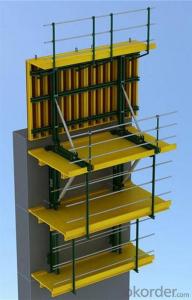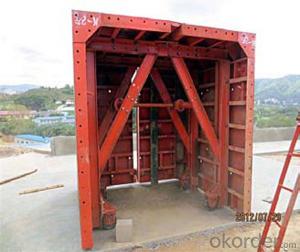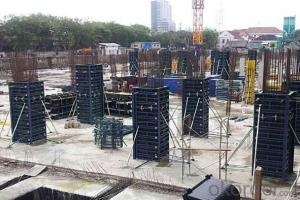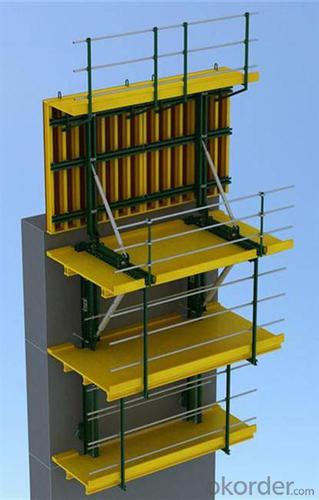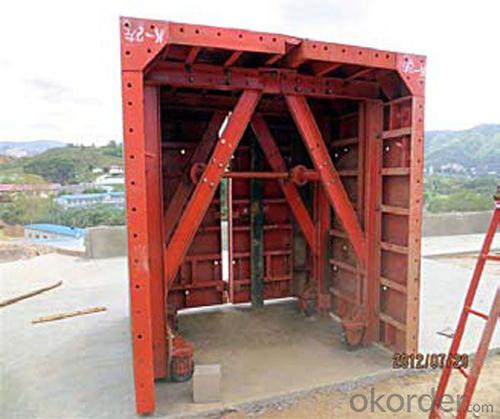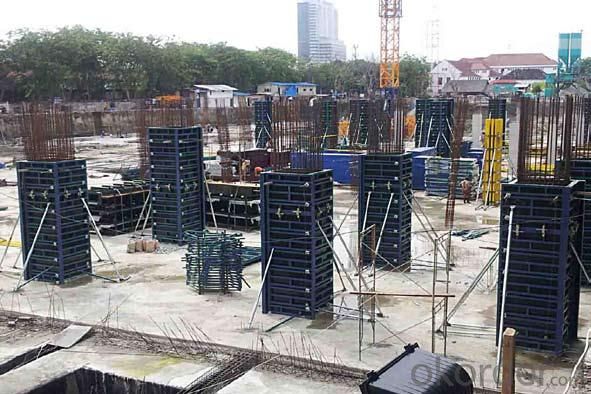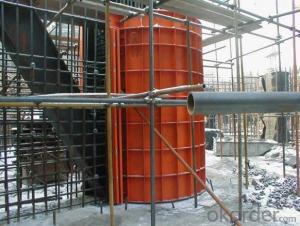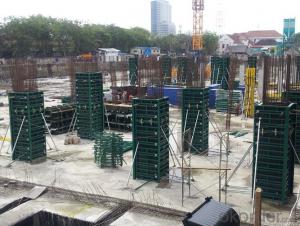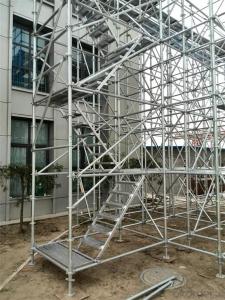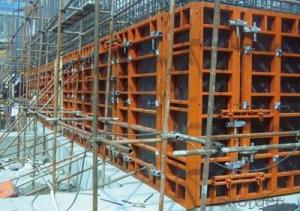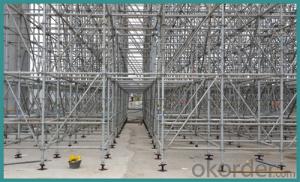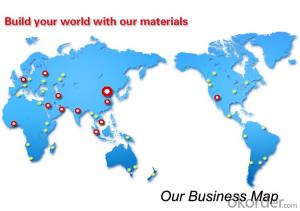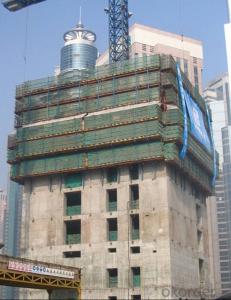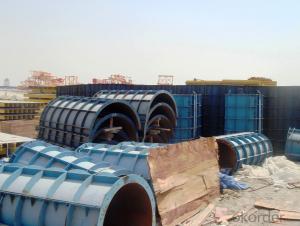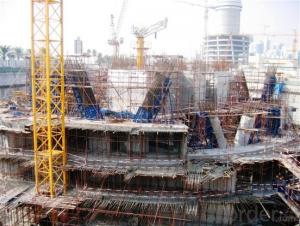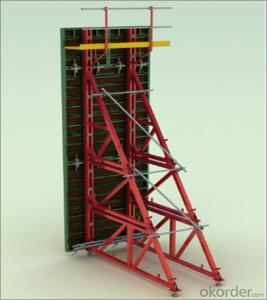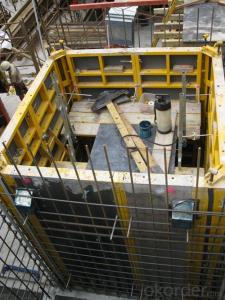Plastic Scaffold System Formwork System Formwork low price
- Loading Port:
- Tianjin
- Payment Terms:
- TT OR LC
- Min Order Qty:
- 30 m.t
- Supply Capability:
- 1000 m.t/month
OKorder Service Pledge
OKorder Financial Service
You Might Also Like
Plastic Scaffold System Formwork System Formwork low price
Product pictures:
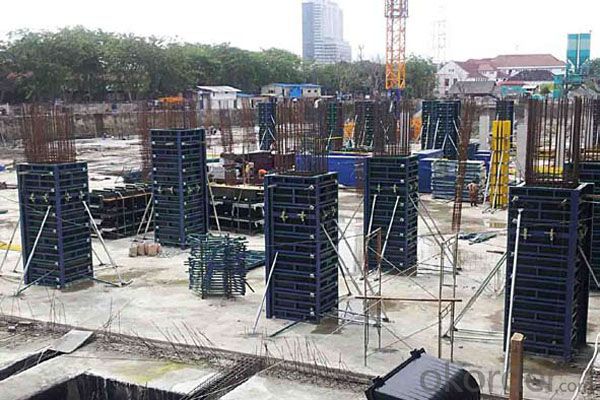
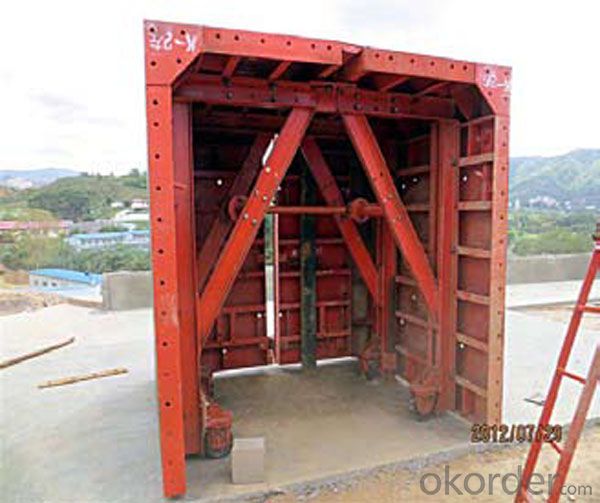
Product description:
Name: | RingLock Scaffold System |
Category: | Scaffolding System |
Material: | Steel (Q235/Q345) |
Size: | D48*3.25mm, etc |
Surface: | Electro Galvanized, Hot Dipped Galvanized, Painted, Powder Coated |
Component: | Standard, Ledger, Diagonal Brace, Bracket, Base Jack, U Head Jack, Etc. |
Application: | Slab Support, Staircase, Stage Plateforms, Bridge Support, Mobile Tower, etc. |
Manufacturer: | OEM is Available |
Items or goods can be manufactured according to your standards. | |
Advantage
* Good loading capacity
* Easy to assemble and dismantle
* Excellent quality for formwork & scaffolding with wide choices
Other scaffolding & formwork products:
(1) Scaffolding System:
(2) Scaffolding Frame & Accessories:
(3) Scaffolding Couplers/Clamps:
(4) Formwork System Scaffolding & Accessories:
Company introduce and advantages:
1. One of Fortune 500 companies in the world. No. 5 in the building material fi eld.
2. Six Sigma strategy , which means no more than 3.4 defects existing among one million of error
possibilities.
3. In line with the business, we launched E-business platform Okorder.com.
4. We are highly recognized by our business partners and clients all over the world and has obtained rapid
development under the spirit of win-win.
FAQ
Why Us?
We are one of the largest construction materials suppliers in China.
We own professional manufacturers with powerful producing capacity.
Extensive and comprehensive quality control system
Excellent products with competitive prices.
Efficient services in pre and after sale.
Full energy with affluent experience team.
- Q: Can steel frame formwork be used for both precast and cast-in-place concrete beams?
- Both precast and cast-in-place concrete beams can utilize steel frame formwork. This adaptable and sturdy system can easily be adjusted to different construction approaches. When it comes to precast beams, the steel frame formwork is employed to fashion the mold or template where the concrete is poured and left to solidify. Once the concrete has hardened, the formwork can be taken off, resulting in a precast beam that can be transported and installed at the construction site. Similarly, for cast-in-place concrete beams, steel frame formwork is used to create a temporary mold or template for pouring the concrete. The formwork provides support and structure to the concrete during the pouring and solidifying process. Once the concrete has set, the formwork can be removed, leaving behind a cast-in-place beam that becomes an integral part of the overall structure. Steel frame formwork offers numerous benefits for both precast and cast-in-place beams. It provides exceptional strength and stability, enabling the creation of beams with intricate shapes and sizes. The steel frame formwork is easily assembled and disassembled, making it efficient and cost-effective. Additionally, it is reusable, reducing waste and promoting sustainability in construction projects. In conclusion, steel frame formwork is a suitable option for both precast and cast-in-place concrete beams. Its versatility, durability, and user-friendly nature make it the preferred formwork system for various construction methods.
- Q: How long does it take to assemble steel frame formwork?
- The time it takes to assemble steel frame formwork can vary depending on the complexity of the project and the experience of the workers involved. However, in general, it can take anywhere from a few hours to a few days to complete the assembly process.
- Q: What are the common quality assurance procedures for steel frame formwork systems?
- Common quality assurance procedures for steel frame formwork systems include: 1. Inspection of materials: This involves checking the quality and specifications of the steel frames, formwork panels, and other components used in the system. 2. Welding and fabrication inspections: Ensuring that all welding joints are properly executed and inspected for quality, strength, and adherence to standards. 3. Dimensional checks: Verifying that the steel frames and formwork panels are manufactured to the correct dimensions and are within acceptable tolerances. 4. Load testing: Conducting load tests to ensure that the formwork system can withstand the required loads and pressures without failure. 5. Surface treatment inspections: Checking the surface coating or treatment of the steel frames for corrosion resistance and durability. 6. Documentation and record keeping: Maintaining comprehensive records of inspections, tests, and certifications to ensure traceability and compliance with quality standards. 7. Regular maintenance and servicing: Implementing a schedule for routine maintenance and servicing of the formwork system to ensure its ongoing performance and safety.
- Q: What are the different types of ties used to secure the formwork to the concrete structure?
- There are several types of ties commonly used to secure formwork to a concrete structure. These ties play a crucial role in ensuring the stability and integrity of the formwork system during the pouring and curing of concrete. The different types of ties used include: 1. Snap ties: Snap ties are one of the most commonly used types of ties. They consist of two parts, a metal rod and a flat plate or washer. The rod is inserted through holes in the formwork panels and then secured with a washer on the outside. Snap ties provide excellent strength and are easy to install and remove. 2. Wedge ties: Wedge ties are similar to snap ties but use a wedge-shaped metal device instead of a washer to secure the rod. The wedge is driven into the tie rod, creating a firm connection between the formwork panels. Wedge ties are quick to install and offer good strength and stability. 3. Form ties: Form ties are commonly used for larger formwork systems. These ties consist of two parts, a metal rod and a flat plate or cone-shaped device. The rod is inserted through the formwork panels, and the plate or cone is placed on the inside, providing a secure connection. Form ties are known for their high load-bearing capacity and are often used in vertical formwork applications. 4. Coil ties: Coil ties are flexible and versatile ties used for various formwork applications. They consist of a coil-shaped wire that is inserted through the formwork panels and then twisted to secure the connection. Coil ties can be easily adjusted to fit different formwork thicknesses and are commonly used for curved or irregular-shaped structures. 5. She-Bolts: She-Bolts are a type of tie used for formwork systems with tie holes or inserts pre-installed in the concrete structure. These ties consist of a threaded rod and a plate or cone-shaped device. The rod is inserted through the tie hole or insert, and the plate or cone is tightened against the formwork to secure it in place. She-Bolts provide a strong and reliable connection and are commonly used in horizontal formwork applications. It is important to select the appropriate type of tie based on the specific requirements of the formwork system and the concrete structure. The choice of tie will depend on factors such as load-bearing capacity, ease of installation and removal, adjustability, and the shape and size of the formwork.
- Q: How does steel frame formwork contribute to the overall soundproofing of a structure?
- The main function of steel frame formwork is to provide temporary support and shape to the concrete during construction. However, it's important to note that soundproofing in a structure is typically achieved through the use of specific building materials and techniques. Soundproofing techniques involve the use of insulation materials such as acoustic foam or mineral wool, as well as the installation of soundproof windows and doors. Steel frame formwork, on its own, does not directly contribute to soundproofing. However, it can indirectly influence the overall soundproofing of a structure. During the construction process, including the installation of steel formwork, it is crucial to ensure precision to avoid any gaps or cracks that could allow sound to pass through. By ensuring a tight and well-constructed concrete structure, the overall soundproofing of the building can be improved. Besides, the use of steel frame formwork may also impact the weight and density of the structure, which can indirectly affect its soundproofing properties. A heavier and denser structure tends to provide better sound insulation. However, it's worth noting that the influence of steel frame formwork on the weight and density of the structure may be relatively minimal compared to other factors such as wall construction materials and insulation. To summarize, while steel frame formwork does not directly contribute to the overall soundproofing of a structure, it can indirectly influence it by ensuring a well-constructed concrete structure and potentially impacting the weight and density of the building. However, achieving effective soundproofing requires the use of dedicated soundproofing materials and techniques specifically designed for that purpose.
- Q: What are the key quality control measures for steel frame formwork installation?
- There are several key quality control measures that should be followed for steel frame formwork installation. These measures are crucial to ensure the structural integrity and safety of the formwork system. 1. Proper inspection: Before starting the installation process, it is important to thoroughly inspect the steel frame formwork. This includes checking for any damages, defects, or missing components. Any issues should be addressed and resolved before proceeding with the installation. 2. Accurate alignment: The steel frame formwork should be properly aligned to ensure that it fits together seamlessly and provides a stable structure. This includes checking the vertical and horizontal alignment of the components, as well as ensuring that they are level and plumb. 3. Secure connections: The connections between the steel frame formwork components should be secure and tight. This can be achieved by using appropriate fasteners, such as bolts or screws, and ensuring that they are properly tightened. Loose connections can lead to instability and compromise the integrity of the formwork system. 4. Level and flat surfaces: The surfaces of the steel frame formwork should be level and flat to provide a stable and uniform support for the concrete. This can be achieved by using leveling tools, such as spirit levels or laser levels, to ensure that the formwork is properly aligned and adjusted. 5. Reinforcement placement: If reinforcement bars are required in the formwork system, they should be properly placed and secured. This includes ensuring that the bars are correctly positioned and adequately supported to prevent displacement during the concrete pouring process. 6. Adequate bracing: Steel frame formwork should be adequately braced to provide stability and prevent any deformation or collapse. This can be achieved by using diagonal braces or stiffeners, as well as ensuring that all bracing components are properly secured and tightened. 7. Regular inspection and maintenance: Throughout the installation process, regular inspections should be conducted to identify any potential issues or defects. Any damages or defects should be repaired or replaced immediately to ensure the safety and effectiveness of the formwork system. By following these key quality control measures, the steel frame formwork installation can be carried out efficiently and effectively, resulting in a robust and reliable structure for concrete casting.
- Q: What are the different types of alignment systems used with steel frame formwork?
- Steel frame formwork commonly utilizes various types of alignment systems to achieve accurate and precise alignment of the formwork components, enabling the construction of straight and level concrete structures. Some of these alignment systems include the following: 1. Adjustable Alignment Bolts: This widely used system involves the installation of adjustable bolts at the corners of the steel frame formwork. By adjusting these bolts, the formwork can be leveled and aligned properly. 2. Alignment Clamps: To maintain the alignment of the formwork panels during the concrete pour, alignment clamps are employed. These clamps securely hold the panels together, preventing any movement or shifting during the construction process. 3. Alignment Pins: Alignment pins are inserted into pre-drilled holes in the formwork panels, aligning and connecting them securely. These pins ensure that the panels are properly aligned and firmly joined together. 4. Alignment Wedges: Alignment wedges are used to adjust and align the steel frame formwork panels. They are inserted between the panels and can be easily adjusted to ensure levelness and proper alignment. 5. Magnetic Alignment Systems: This type of alignment system utilizes powerful magnets to hold the formwork panels in place and maintain their alignment. Particularly advantageous for steel frame formwork, the magnets create a strong and secure connection between the panels. In summary, the diverse range of alignment systems used with steel frame formwork is designed to guarantee precise alignment and accuracy of the formwork components. These systems are instrumental in achieving the desired quality and finish of concrete construction projects.
- Q: Can steel frame formwork be used for both cast-in-place and precast concrete construction?
- Yes, steel frame formwork can be used for both cast-in-place and precast concrete construction. Steel frame formwork provides a versatile and durable solution that can be easily adjusted and reused for different construction projects. It ensures precise and accurate shaping of concrete elements, whether they are cast on-site or produced in a precast facility.
- Q: Are there any specific safety precautions to consider when using steel frame formwork?
- There are multiple considerations to take into account regarding safety when using steel frame formwork. Some of these precautions include: 1. Adequate training: It is crucial that all workers involved in utilizing steel frame formwork receive proper training on its setup, usage, and dismantling. This training should encompass load limitations, safe assembly procedures, and methods to avoid common hazards. 2. Examination: Prior to employing steel frame formwork, it is essential to thoroughly inspect it for any defects or damage. This involves checking for cracks, bent or impaired components, loose connections, or any other issues that could compromise its structural integrity. If any defects are detected, the formwork should be repaired or substituted prior to use. 3. Stability and support: Proper bracing and support should be provided to ensure the stability of steel frame formwork during construction activities. This includes employing suitable props, ties, and supports to prevent the formwork from shifting or collapsing. 4. Fall protection: Working at elevated heights is prevalent when employing steel frame formwork, thus it is imperative to have appropriate fall protection measures in place. These measures may entail the utilization of safety harnesses, guardrails, or safety nets to prevent falls and safeguard workers from severe injuries. 5. Load capacity: Steel frame formwork has specific load limits, and it is vital to ensure that these limits are not surpassed. Overloading the formwork can lead to structural failure, collapse, or accidents. Proper planning and calculation of loads should be conducted to ensure that the formwork is used within its safe capacity. 6. Communication: Effective communication among workers utilizing steel frame formwork is crucial for maintaining safety. This includes conveying clear instructions, warnings, and signals to coordinate activities and avoid accidents. 7. Personal protective equipment (PPE): Workers should always wear appropriate PPE, such as hard hats, safety boots, gloves, and eye protection, to shield themselves from potential hazards associated with the use of steel frame formwork. By adhering to these safety precautions, the likelihood of accidents, injuries, and structural failures can be minimized, thereby ensuring a secure working environment when employing steel frame formwork.
- Q: How does steel frame formwork prevent the formation of concrete shrinkage cracks?
- Steel frame formwork prevents the formation of concrete shrinkage cracks by providing strong and rigid support to the concrete during the curing process. It ensures that the concrete remains in its desired shape and position, preventing any movement or displacement that could lead to crack formation. Additionally, the steel frame formwork helps in evenly distributing the forces and stresses exerted by the curing concrete, minimizing the potential for shrinkage cracks to develop.
Send your message to us
Plastic Scaffold System Formwork System Formwork low price
- Loading Port:
- Tianjin
- Payment Terms:
- TT OR LC
- Min Order Qty:
- 30 m.t
- Supply Capability:
- 1000 m.t/month
OKorder Service Pledge
OKorder Financial Service
Similar products
Hot products
Hot Searches
Related keywords
